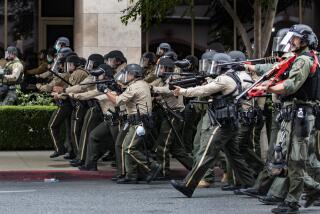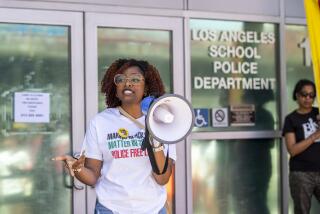They took to the streets after George Floyd’s murder. Now, they fight to keep change going
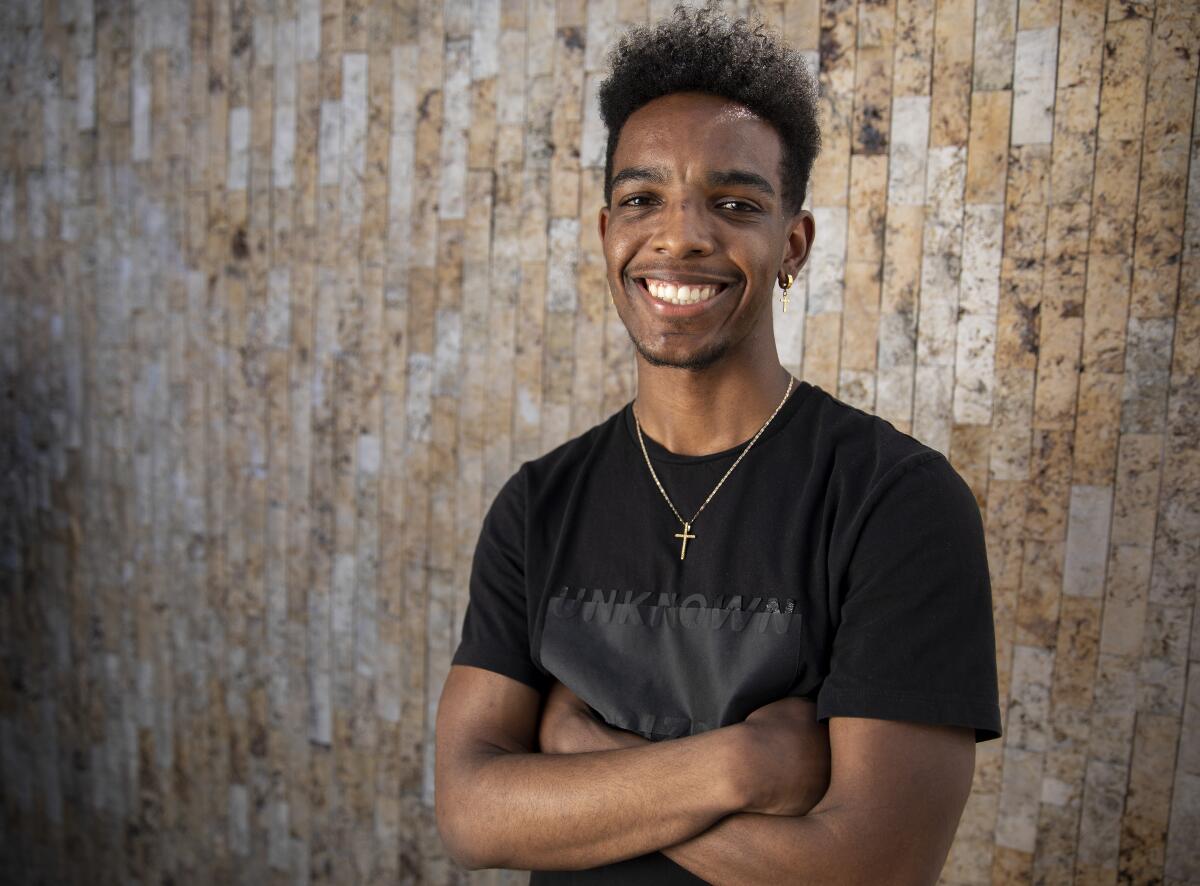
Jai’Ree Tannan stepped onto the stage erected in the shadow of the police union’s headquarters in Los Angeles’ Westlake neighborhood.
The 20-year-old stood away from the microphone, listening intently as a fellow student activist gave voice to the crowd. “We got cops off campus,” the female speaker declared. “We did that!”
Tannan nodded proudly. “Woooo!” cheered the crowd that had gathered on a recent afternoon for the rally organized by Black Lives Matter Los Angeles.
Following a prolonged campaign led by students, including Tannan, the L.A. Board of Education in February approved a plan to drastically shrink its police force on LAUSD campuses, ban the use of pepper spray on students and use the diverted funds to improve the education of Black students.
A core group of L.A. student activists has been pushing to defund school police for years. But the movement gained much broader traction after George Floyd’s death one year ago.
That trajectory held true for Tannan’s own activism. Although he’d been involved in social justice causes for a few years, Tannan, who works at a warehouse in Chino and plans to study visual effects at the Academy of Art University in San Francisco in the fall, said he became more engaged in the past year.
“That gave me so much hope,” he said of the successful student campaign, calling it the high point of a hard — but also transformative — time.
George Floyd died on May 25, 2020, after his neck was squeezed to the pavement beneath the knee of Minneapolis police officer Derek Chauvin, who last month was found guilty of second- and third-degree murder and second-degree manslaughter. The killing, captured on viral video, spurred the largest U.S. social justice protests in at least half a century, reshaped the public posture of institutions and corporations toward systemic racism and shifted political winds on everything from voting rights to police reform to the 2020 presidential race.
The protests following Floyd’s death not only galvanized thousands of young activists like Tannan, but also gave a broader platform to prominent longtime civil rights advocates, including several influential leaders in L.A.
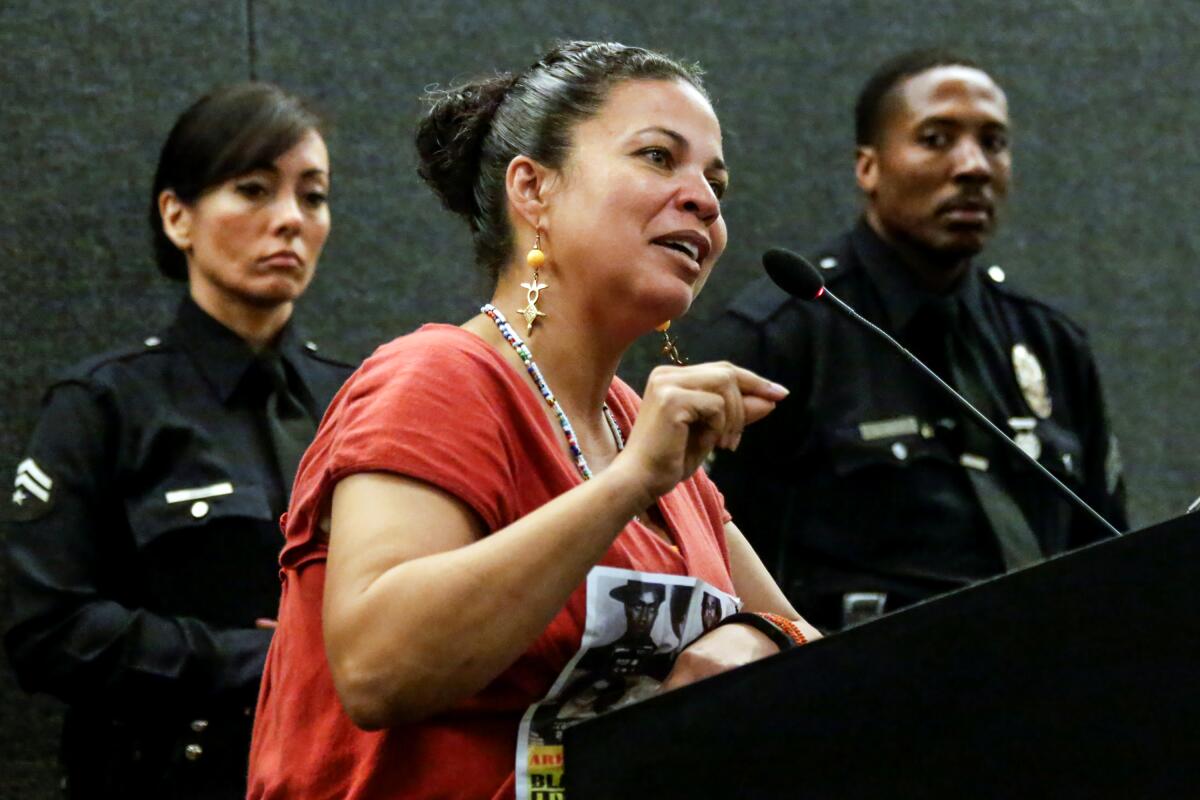
“People finally get what we mean when we say, ‘Until Black people are free, nobody’s free,’” said Melina Abdullah, the leader of Black Lives Matter L.A. “Until George Floyd, we had to constantly beat back this question of, ‘Why do we say Black lives matter?’”
Another legacy of the past year, Abdullah said, is that the “almost performative solidarity” displayed by some non-Black people in support of Black Lives Matter in the past has been replaced by what she calls a more “organic solidarity.” In prior years, non-Black people might have bought a BLM T-shirt, she said, but often weren’t willing to engage in conversations around topics such as investing resources in Black communities.
Abdullah also takes deep pride in watching the growth among a new generation of activists, including her teenage daughter Amara, who recently helped start a political-theory training camp that will start in June.
“What 14-year-old says, ‘My idea of a good time during the summer is talking about the difference between Marxism and African socialism’?” Abdullah said, chuckling.
And yet, she said, it has been a personally exhausting year. In August, police officers with assault rifles descended on her home, saying they’d gotten a call about a man holding her family hostage. Police later said the dangerous hoax was probably a “swatting” incident, in which someone fakes an emergency call so that armed police swarm to an address.
Her children were severely traumatized, Abdullah said, and she relocated her family outside the city for four months while her family sought counseling.
::
While it’s hard to yet fully assess the legacy of the past year, a time defined by twin upheavals — a global pandemic and a generational reckoning with American racism — the events of 2020 already have altered many of our rhythms.
In the weeks after Floyd’s murder, the size and scope of protests continued to build and people marched not only in big cities but also in small towns across every state in the nation. Massive donations poured into bail bonds funds and the Black Lives Matter Global Network Foundation took in $90 million last year, more than 10 times its operating expenses.
Some American institutions, including this newspaper, issued public apologies, reckoning with the ways they had perpetuated racism; many others vowed to do more to eliminate implicit biases. Eleven days after Floyd’s death, the National Football League, viewed by some as complicit in ending the career of quarterback Colin Kaepernick after he kneeled in protest against police brutality in 2016, tweeted: “We, the NFL, believe Black Lives Matter. #InspireChange”
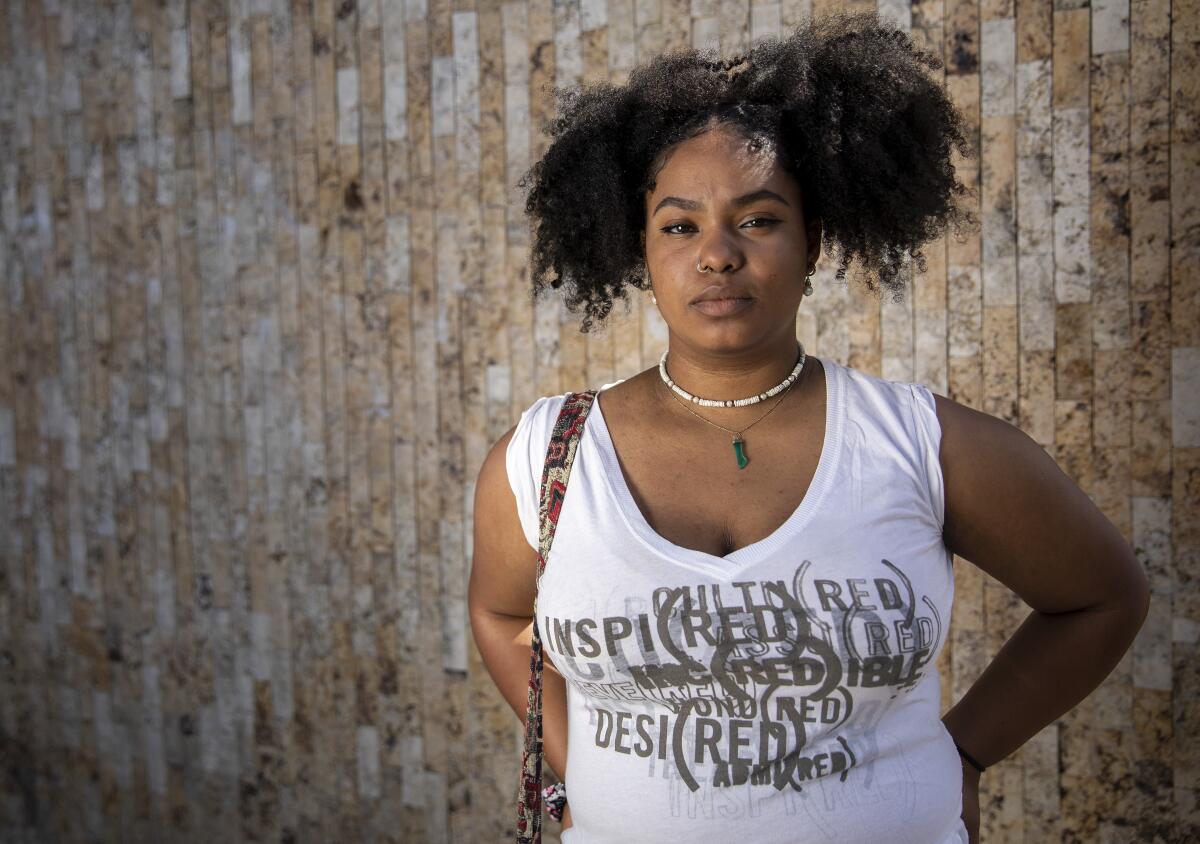
Abdullah’s older daughter, Thandiwe, 17, said it was frustrating to watch corporate America co-opt a movement she’d been a part of since she was 9 — a movement that, not long ago, was equated by critics with terrorism.
“Being in Black Lives Matter had consequences on my life growing up,” she said, mentioning the year her mother got arrested at a protest and spent some of Christmas Day in jail. “So now, all the sudden I’m seeing huge corporations that were once shying away from the controversy of even admitting that my life matters, saying, ‘Hey, your life, it matters now ... so here’s a 50%-off, all-black hoodie.’”
After Floyd’s murder, the days blurred together. Thandiwe stayed in bed for days, trying to avoid Instagram, where the video of Floyd’s killing filled her feed.
“To see the life sucked out of him again and again and again on people’s stories … ,” she said, her voice trailing off.
In the months that followed, stories of the deaths of people of color — some through illness, others claimed by violence — dominated headlines.
In L.A. County, as in most of the nation, Black and Latino people were being hospitalized and dying of COVID-19 at disproportionately high rates.
Two weeks after Floyd’s murder, someone walking through a park near Palmdale City Hall found the body of Robert Fuller, a 24-year-old Black man, hanging from a tree. Spurred in part by a tweet about Fuller’s death posted by Kim Kardashian, a huge crowd of protesters arrived in Palmdale demanding justice for Fuller, whose death was ultimately deemed a suicide, a finding still questioned by some residents.
“This is a never-ending battle, not just with George Floyd but with every Black man and Black woman in America,” said Isabel Flax, who is part of the Cancel the Contract coalition of advocacy groups in the Antelope Valley that wants funding to be redirected from policing toward social services.
In the weeks after Floyd’s murder, it quickly became clear that a broader swath of the public had begun to think about and, in some parts of the country, support proposals to defund or restructure police forces.
In the Pacific Northwest, some cities considered plans for reimagining policing, including a proposal to dispatch civilians instead of officers on some calls. And in July, the Los Angeles City Council voted to cut $150 million from the Police Department’s budget, a marked departure from the upward trend in recent years.

For Brenda Gutierrez, a crisis counselor who works with victims of domestic violence and sexual assault, it felt so encouraging to see the fruits of years of organizing about funding issues, including the 2017 campaign urging the city to divest from Wells Fargo after the sham-accounts scandal, finally resonate with a wider public.
“I think people are becoming aware that the police are not the only thing that needs money,” she said, adding that she hopes to see more funds reallocated toward social workers, schools and domestic violence shelters.
Last spring, during the early weeks of shutdowns, she was getting nearly constant calls from women cooped up at home with their abusive partners, some of whom had lost their jobs. The bills weren’t getting paid, the women told her, and everything felt out of their control.
Everything about the year already felt burdensome, said Gutierrez, 38. Then, shortly after Floyd’s murder, her sister-in-law asked if Gutierrez had watched the video of his death. She started to watch it, but quickly turned away, wary of consuming too many traumatic images.
She joined the protests in downtown L.A. and was stunned by the size and diversity of the crowd. She’d attended Black Lives Matter protests in the past, she said, when it was only her and a few others demanding the resignation of then-L.A. County Dist. Atty. Jackie Lacey, who drew fierce criticism for refusing to file charges in several high-profile police shootings.
Gutierrez vividly remembers the feeling of community last summer — the way someone always showed up with snacks and water for the demonstrators, and the time a fellow protester she’d met hours earlier left a note on her windshield saying they hoped she’d made it back to her car safely.
“I can’t even describe it,” she said, “just to see the solidarity.”
More people in her circles seemed to be getting interested in issues of police brutality, she said, but also about things such as the environment and healthcare. When talking with neighbors and relatives, she noticed they were more receptive to conversations about the root causes of racism and other societal failures.
“People I didn’t expect to have these conversations with were a lot more open,” she said. She felt encouraged in the months that followed, as many Confederate statues across the country were taken down, and Washington, D.C.’s NFL team dropped its “Redskins” name.
But she felt devastated again in March when a white man went on a rampage in the Atlanta area, targeting spas and killing six women of Asian descent.
“Why aren’t we changing?” she thought.
Recently, Gutierrez joined the Westlake rally. Surveying the crowd, she smiled.
“Even though you don’t see as many people out here now,” she said, “at least you still see people.”
Standing nearby, Tannan, the student leader, recalled how emotionally numb he had felt watching the video of Floyd’s death: He has seen so many recordings of police officers killing unarmed Black men over the years.
But one specific detail from the video, the sound of Floyd wheezing, has stuck in his memory.
“It wasn’t traumatizing, because, again, I am desensitized to these things,” Tannan said. “But it was heartbreaking.”
More to Read
Start your day right
Sign up for Essential California for news, features and recommendations from the L.A. Times and beyond in your inbox six days a week.
You may occasionally receive promotional content from the Los Angeles Times.
